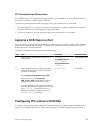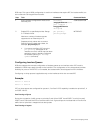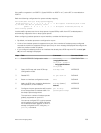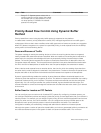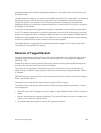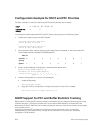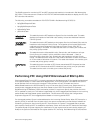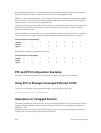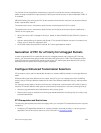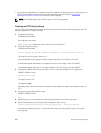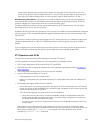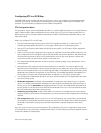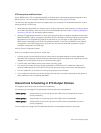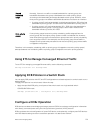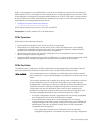
The internal Priority assigned for the packet by Ingress FP is used by the memory management unit
(MMU) to assign the packet to right queue by indexing the internal-priority to queue map table (TABLE 1)
in hardware.
PRIO2COS setting for honoring the PFC protocol packets from the Peer switches is as per above Packet-
Dot1p->queue table (Table 2).
The packets that come in with packet-dot1p 2 alone will be assigned to PG6 on ingress.
The packets that come in with packet-dot1p 2 alone will use Q1 (as per dot1p to Queue classification –
Table 2) on the egress port.
• When Peer sends a PFC message for Priority 2, based on above PRIO2COS table (TABLE 2), Queue 1 is
halted.
• Queue 1 starts buffering the packets with Dot1p 2. This causes PG6 buffer counter to increase on the
ingress, since P-dot1p 2 is mapped to PG6.
• As the PG6 watermark threshold is reached, PFC will be generated for dot1p 2.
Generation of PFC for a Priority for Untagged Packets
In order to generate PFC for a particular priority for untagged packets, and configuring PFC for that
priority, you should find the queue number associated with priority from TABLE 1 and Associate a DCB
map to forward the matched DSCP packet to that queue. PFC frames gets generated with PFC priority
associated with the queue when the queue gets congested.
Configure Enhanced Transmission Selection
ETS provides a way to optimize bandwidth allocation to outbound 802.1p classes of converged Ethernet
traffic.
Different traffic types have different service needs. Using ETS, you can create groups within an 802.1p
priority class to configure different treatment for traffic with different bandwidth, latency, and best-effort
needs.
For example, storage traffic is sensitive to frame loss; interprocess communication (IPC) traffic is latency-
sensitive. ETS allows different traffic types to coexist without interruption in the same converged link by:
• Allocating a guaranteed share of bandwidth to each priority group.
• Allowing each group to exceed its minimum guaranteed bandwidth if another group is not fully using
its allotted bandwidth.
ETS Prerequisites and Restrictions
The following prerequisites and restrictions apply when you configure ETS bandwidth allocation or queue
scheduling.
• Configuring ETS bandwidth allocation or a queue scheduler for dot1p priorities in a priority group is
applicable if the DCBx version used on a port is CIN (refer to Configuring DCBx).
Data Center Bridging (DCB)
265



